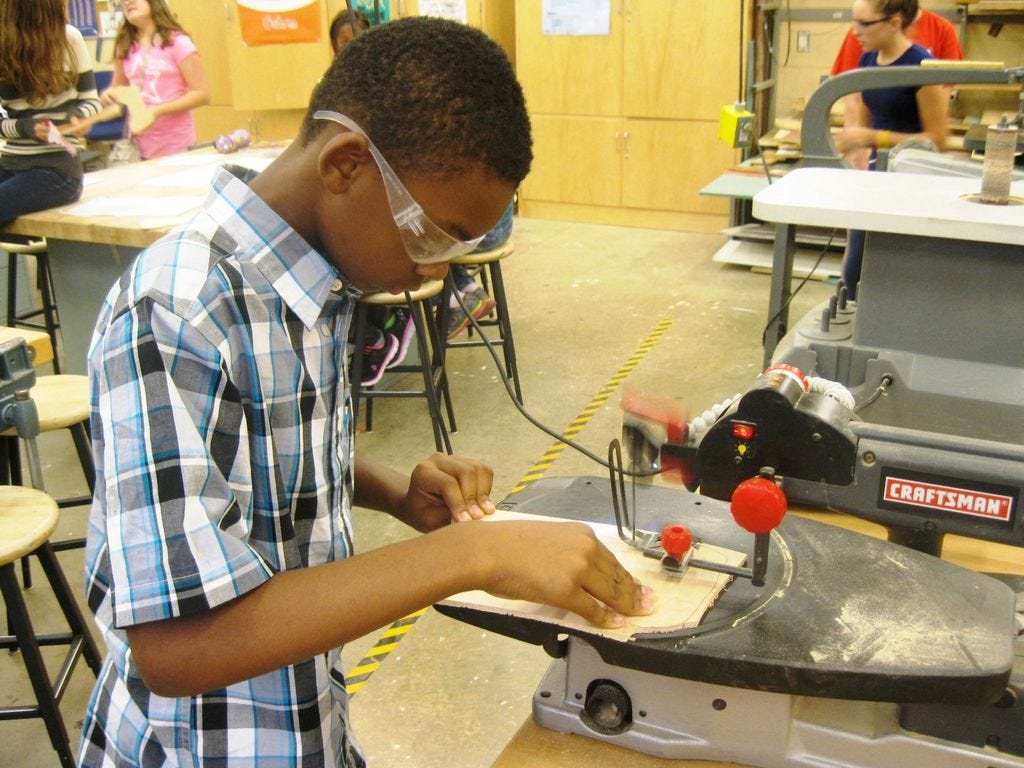
CRESTVIEW — There’s one middle school industrial arts program in Florida, and Crestview has it.
But it may end after the program's teacher retires after this school year.
And that, its teacher said, would be detrimental to students.
“What about the kids who don’t go to college?” Shoal River Middle School industrial arts teacher Dale Chavers said. “What are they going to do when they leave high school?”
Chavers spent much of his professional life building the program, first at the former Richbourg Middle School and then at Shoal River after Richbourg moved to its new location.
“This was going to be the feeder program for the kids to go to Crestview High School,” he said.
When the Crestview High CHOICE carpentry teacher retired in 2009, the program retired with him. Some of the equipment migrated to Chavers’ shop. Some of it’s still at the high school.
Then-Principal Ed Coleman and his successors, Bob Jones and Dexter Day, respectively, have tried to fill Fleming’s position, but have had no qualified applicants, Day said.
“There was no interest,” he said.
THE HEAT IS ON
Despite a lack of interest, building trades in area high schools are not dead. Crestview High, as well as Baker and Laurel Hill schools, offer CHOICE welding programs. And Crestview High has a related program planned.
“We want to implement, with the support of CHOICE, heating, ventilation and air conditioning,” Day said.
Day said he respects the carpentry program, but demand has shifted toward metal building fabrication.
“There are a lot of metal buildings, but a carpentry lab teaches wood and hammer and nails,” he said. The planned HVAC program responds to an industry need, Day said.
“My home is serviced every so often by the air conditioning guy,” he said. “It’s something that’s recurring in homes. But when you build a house, you’re done. You don’t have to build a new house.
“But that air conditioning guy is always going to be needed during the life of the house.”
MORE THAN HAMMERS AND SAWS
Chavers said his program is much more than building the set of bookshelves or a birdhouse his students’ fathers and grandfathers made in their shop classes.
One recent morning, sixth- and seventh-graders shared drafting scales and discussed the pros and cons of floor plans they drew for their dream homes.
“This is what we gotta have, and we have to start them at this age and pique their interest early,” Chavers said.
Preparing floor plans is just the start, he said. Next, the kids will build the house, starting with the wood framing. It won’t be a full-sized house — that’s where scale rulers come in — but the model will be accurate, down to the last stud.
It all leads to graduating students with construction skills from design to actual building that catch contractors’ attention, Chavers said.
“When you get an eighth-grade student that can walk onto a job site and read a set of blueprints, companies are impressed,” he said.
WOODWORKING TO HORTICULTURE
Laurel Hill School's agriculture, horticulture and agri-science program begins at the middle school level, and it’s not all about planting cycles and soil.
“In our program, it calls for being familiar with hand tools,” teacher Jerry Gregory said. “In their first little woodworking project, they practice with a saber saw or jig saw.
“When they get skilled enough, we let them get working on their own project — usually a shelf or a gun rack or a fishing pole rack. It adds to some of these kids’ interest.”
As students progress to the high school level, they can explore more comprehensive agricultural studies, or choose construction.
“I give them a choice of working with plants, if they’re interested in working with plants,” Gregory said. “Otherwise, they go to the shop side and have a welding, woodworking or occasionally metal working project.”
CERTIFICATION AND THE REAL WORLD
Students who complete Gregory’s and other area high school teachers’ programs receive certification through the National Center for Construction Education and Research.
Then they go to work. Gregory’s ninth-graders are building bookshelves under contract for the Okaloosa County School District.
“Before they get their welding cert at any of these schools, they have to go through a core curriculum, and that includes small hand tools,” Gregory said. “By the time my kids get into the ninth-grade, they’re pretty familiar with everything so it doesn’t take them quite as long.”
It may not quite be what Chavers wants perpetuated, but it incorporates many of its tenets.
Now, he just wants to retire, assured his years of building up Shoal River’s industrial arts program aren’t for naught.
“I don’t want the program to die,” he said. “I’ve put too many years into it.”
This article originally appeared on Crestview News Bulletin: Florida's last middle school industrial arts program may close, but opportunities remain
